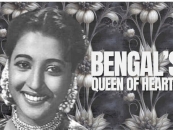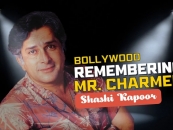-853X543.jpg)
Close Encounters with Rekha
by Khalid Mohamed October 10 2020, 12:00 am Estimated Reading Time: 11 mins, 22 secsOn her 66th birthday, Khalid Mohamed writes on the eternal mystique of Rekha.
It’s that time of the year. She turns 66 today (October 10).
And she or her secretary Farzana may or may not take phone calls. Neither do I intend to attempt to get in touch for the mandatory,
“Happy birthday.” Simply because it’s always a chore to reach her on her landline (her cell phone number is Bollywood’s best-kept secret).
Still, it’s not quite in me to ignore the momentous day in her life: at 66 she continues to draw oohs-and-aahs from both men and women, who can’t be categorised in the buzzy category of ‘the millennials’.
Since the outbreak of the pandemic, she hasn’t been seen or heard of, except for the news item that her bungalow at Bandra’s Carter Road had been marked by the municipal authorities. Perhaps one or some of her staffers had been detected COVID-19 positive. We’ll never know. And that’s just as well, since we’d like to imagine a radiant Rekha today - a Rekha who had planned to set up her own official website (did she ever? Can’t figure). And she had asked me for a bio-summary of her career.
So my epistle to the Ma’am Re, as she is often called, kicks off with that summary… and if you’re still reading, there’s a description of some of my encounters with Ma’am, which I can recall from the memory files.
At the outset, the CAREEROGRAPHY:
Every Indian has an image about Rekha - an image linked with timelessness, beauty and a surviving spirit. She embodies the female spirit and yet tantalisingly enough, with a certain vulnerability.
Rekha Ganesan, daughter of the charismatic Tamil and Telugu actress of yore Pushpavalli, and the versatile actor Gemini Ganesan, traces her roots to Chennai, a seat of traditional learning. She began as a child artiste in Rangola Ratnam (1966), before she even knew what the camera or cinema meant.
Perhaps it was ordained that the baby steps would culminate in a career of close to 200 films in four decades, in as many Indian languages, and is today rated as an actress who after a clumsy start evolved into an artiste of substance.
A tough act that - considering the fact that she did not succumb to the formulaic roles of the helpless, male-crutch seeking woman. Every performance has had its impact, be it glamorous or starkly real, be it in a cameo or in projects that have hinged entirely on her calibre.
Rekha – a name which means the divine line of control – is so much part of her persona that in the public mind, it is associated with her. She is innately aware of the thin line that separates the ordinary from the extraordinary.
The transition from a girl to a woman – compelled to forsake the most precious years of life in the heat and dust of the film studios – was rocky. A girl, who could be a laugh-out-loud hilarious mimic of the actresses of her time – initially, her dance movements were reminiscent of Mumtaz’s -- eventually graduated towards becoming a certified original.
_(1).jpg)
Her first Bombay film, Sawan Bhadon (1970), presented her as a tomboyish rural girl, a role, which seems to be ironic in retrospect to her re-invented persona - of a trend-setter in fashion and lifestyle.
Cinema happened to her like breathing happens to us all. Almost against her own will, she appeared in a spectrum of films in the 1970s ranging from the purely entertaining; Elaan (1971), Rampur ka Lakshman (1972), Kahani Kismat Ki (1973), Ganga ki Saugandh (1978) and Mr Natwarlal (1979) to more meaningful ones like Namak Haraam (1973), Do Anjaane (1976) and Ghar (1978).
Indeed Ghar, in which she played a rape victim, made her sharpest critics acknowledge the fact that she was capable not only of stardom but also of acting of the highest calibre.
Very few actresses can straddle the glamorous as well as the more believable, which Rekha did effortlessly in Muqaddar ka Sikandar (1978). The film saw her play a courtesan who dies in the throes of lovelessness – a performance that continues to stay in the heart of every person who has loved and lost. After Ghar, there was a certain technical finesse in her performances as well as an emotional density. Simultaneously, a dual personality emerged – a playful young woman as endearing as one’s kid sister (evidenced in Khubsurat,1980) and of a woman of implosive strength (evidenced in Umrao Jaan, 1981). She was also capable of the classic rites of seduction in Utsav (1984).
Earlier in Silsila (1981), she enticed fashion trends across the nation as ‘the other woman’. In fact, her facility for skilful make-up artistry and costume has been consistently remarkable, to the extent that the Rekha look in Muqaddar ka Sikandar, Umrao Jaan and Silsila were emulated across the nation. If she could be the entrancing ‘other woman’ in Silsila, she could be the intelligent, patient wife of Ijaazat, understanding the inevitable consequences of a fluctuating domestic relationship. Or she could be the housewife seeking to find an exit from a meaningless marriage in Astha (1997).
She can be a chameleon, changing from drabness to vivacity with Khoon Bhari Maang (1996). Frequently, simplicity becomes her. As frequently, so does that Hollywood-style flamboyance, asserted by her negative role of a woman who gets whatever and whomever she wants, come what may. This was palpable in Khiladiyon ka Khiladi (1996). The same year saw her brief but striking portrayal of a woman versed in the art of seduction in the English language international film Kama Sutra.
In Rekha’s case, the length of the role is subsidiary if not irrelevant. She made a mark not only in Kama Sutra in a brief appearance but also in Zubeidaa (2001), Koi Mil Gaya (2003) and Krrish (2006). She will act and excel as there is life in her and there is film in camera. Her life is crowded with awards – including the National Award for Best Actress for Umrao Jaan. Her last full-fledged screen appearance was in Super Nani (2014).
Now, Ma’am Re didn’t revert whether this piece pleased or displeased her. Not my job to know that. Neither is it my job to know (and answer my badgering friends since eons) why Rekha and Amitabh Bachchan have never starred in a film again after Silsila. Are they still seeing each other, is the next vicarious question. Go figure out for yourself guys. As that aphorism goes, curiosity killed the meow-meow cat, isn’t it? So on to the next part:
_(1).jpg)
CLOSE ENCOUNTERS
Whenever I have interviewed her over the years, I have had to take a deeper breath like a sea diver and await her entry at her bereft workplace-apartment close to her residence.
Now here’s reducing my countless confabulations with Rekha to the three most representative ones.
Encounter No.1: She wasn’t talking to the press, which was quite a voguish thing to do back in the 1980s. She was shooting on the Bengalaru outskirts for Utsav, I was there to cover the shoot, courtesy Shashi and Jennifer Kapoor. “Will she talk?” I had quizzed Shashi Kapoor who had responded with, “It all depends on her mood.”
On finally summoning up enough courage in Bengalaru to stammer, “Ww..will you talk to me?” Rekha smiled like benevolent royalty, “Why not? We shall talk.” Next morning, scrubbed and shampooed I landed in her hotel suite, motivated by my editor to trip her, bait her, ensnare her about talking about the magnificent obsession of her life, the “him” she refers to elusively.
She doled out veiled statements, something which she continues to do to this day and age. I used all the tricks in the interviewing book to get sensational copy. She was wise to my game, went so far no further. Fair enough. It was a lousy interview but the accompanying black-and-white photographs shot by Shash Kapoor’s son, Karan, were sensational. The editor, in a rare gesture, beamed, “Well, at least you got her to break her silence.” In other words, something was better than a rude rebuff.
_(1).jpg)
Encounter 2: This was a photo-shoot for Filmfare in Lake District, U K. Rekha, trusted secretary Farzana, photographer Ashok Salian and I were there, courtesy Prem Subramaniam of the British Travel Authority. A drive was on to promote England as a prime location for Bollywood units.
Ashok laughed as if there was no tomorrow (he still does), Farzana was the cool and collected one, Ma’am Re was busy selecting the right costumes for the right locations like a flowing scarf for a cliffside, a polo neck for a coffee shop and breeches for a stable for horses.
And if there was a candy boutique there, she posed with the colourful jars of lemon mints, raspberry sweets and chocolate-coated marshmallows, as if she was trying to regain a lost part of her childhood. For three days, it was click, click, click, click. If we talked at all, it must have been about costumes. I came away feeling like an encylopaedia about fabrics, silhouettes and cuts as a fashionista. On landing back in Mumbai in the early morning hours, there was no sign of jet-lag. Ma’am drove from the airport straight to Ashok Salian’s studio to select the photos for publication. The ones she disapproved of were binned. No discussion permitted.
Encounter 3: This was a script session for a film project tentatively titled Mazhab. I read my script to her, a talent, which is as tough for me as speaking in Greek and Latin. It was a story of a fearless woman lawyer, admittedly a female version of the upright lawyer Atticus Finch from Harper Lee’s unforgettable novel To Kill a Mockingbird. Gregory Peck had essayed the part of the lawyer in the film version (1962) for which he had won the Best Actor Oscar.
Be that as it may, I gulped, sweated, sobbed somehow to the end of the 200-pager script adaptation in accordance with the Bollywood tenets. I wanted her to play the lead. At the end of the three-hour session, there was pin drop silence.
Farzana looked at me expressionlessly. Rekha’s pet dog woofed, I looked for a recognisable reaction. Yes? No? Maybe? More silence ensued then she asked, “When are we doing it? We have a lot of work to do - decide on the look, details of the character and so on. The script also needs lots… lots of work.” Whoa, she had said yes without saying yes. I was blissed out. But then show business has its twists and turns. The project couldn’t get sufficient funding because it was woman-centric.
3.jpg)
Producers suggested just change the main character into a man… and speak to Amitabh Bachchan or Shah Rukh Khan or Aamir Khan, you know all of them, don’t you. No way, I couldn’t. Dimple Kapadia was next on my wish-list. At the end of the script read, she sighed, “At least I didn’t fall asleep, so there must be something good about the script.” Unlike Rekha, to be fair Dimple did organize a couple of meetings with potential financiers. “But why a ladies’ picture,” they responded predictably. Eesh, Mazhab is still rotting on my comp.
Mazhab forgotten, I was back again on the print interview beat with Rekha. Meaning I returned to full-time journalism. The rest, as they say, isn’t history.
Encounter No 4: This was the last one with me, what seems like eons ago. Since then, she hasn’t called, neither have I. On occasion, I have left a happy birthday message on her phone’s voice machine. She doesn’t reply but then at one point, she has assured me that we may not meet for quite a while but that doesn’t diminish our mutual regard. Swoon, she knows how to make ordinary mortals feel special.
By the way, before the cutaway, I had approached her to play the role of the Rajmata, which she had essayed with perfection in Zubeidaa. This was for the film’s sequel titled Rutba. Ma’m quoted a price which was equivalent to the film’s entire budget. I balked, mumbling no hard feelings, no hard feelings. Correctly, she reasoned, “Why should the producer gain advantage of the regard we have for each other. Perhaps we will produce it together some day… inshAllah.”
My loss entirely. Because I can see no one else reprising the role of the elegant Rajmata in Zubeidaa 2, with a mind of her own.
And by the way No 2, over time we had talked periodically about doing a book. Snag: she would not speak about her private life. Now how can a biography be possible with a tomb-like silence on the many downers and uppers in her life?
Ma’am Re is whipsmart. Or is she? Like all of us, she clutches the secrets in her diary to her heart. No trespassing allowed. Not now, not ever, never mind the number of candles on the birthday cake.




-173X130.jpg)
-173X130.jpg)


-173X130.jpg)

-173X130.jpg)
-173X130.jpg)